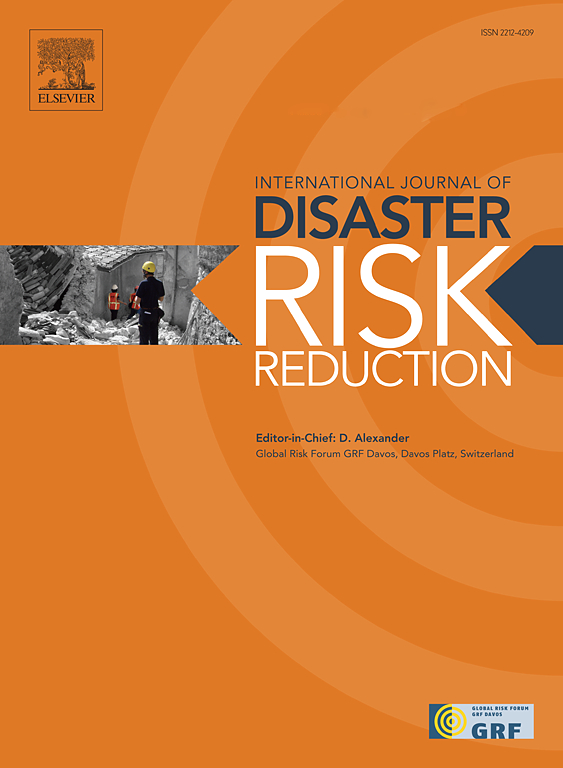评估著名历史清真寺的疏散风险:采用 HM-ERI 框架的定量和定性综合方法
IF 4.2
1区 地球科学
Q1 GEOSCIENCES, MULTIDISCIPLINARY
International journal of disaster risk reduction
Pub Date : 2024-09-29
DOI:10.1016/j.ijdrr.2024.104866
引用次数: 0
摘要
历史悠久的清真寺具有独特的建筑特点和较高的居住密度,给安全高效的疏散工作带来了独特的挑战。本研究介绍了历史清真寺疏散风险指数(HM-ERI),这是一个新颖而全面的框架,专门用于评估这些具有重要文化意义的建筑的疏散风险。HM-ERI 模型综合了从基于代理的模拟中得出的三个定量标准和通过现场评估得出的十七个定性标准,产生了两个无量纲风险分数:对土耳其 12 座著名的 15 和 16 世纪清真寺的分析表明,这些清真寺的 HM-ERIQN (定量风险)和 HM-ERIQL (定性风险)具有不同的疏散风险等级。清真寺的 HM-ERIQN 值从 0.27(低风险)到 0.80(高风险)不等,范围在 0-1 之间,表明潜在的拥挤程度和疏散效率存在差异,模拟总疏散时间从 2 分 46.3 秒到 8 分 18.5 秒不等。HM-ERIQL 值反映了 0-1 级定性因素的严重程度,如缺乏替代出口、鞋架摆放不当、建筑布局复杂和应急准备有限等,范围在 0.46 到 0.73 之间,表明中等风险。HM-ERI 框架综合了专家的判断,并利用了模拟和现场观察的数据,为识别高风险的历史清真寺提供了一个实用工具,并为采取有针对性的干预措施以提高疏散安全提供了信息。这项研究有助于为这些具有重要文化意义的建筑制定更高的疏散标准,从而改进安全评估并指导有效的保护策略,将人的生命和文化遗产放在首位。本文章由计算机程序翻译,如有差异,请以英文原文为准。
Assessing evacuation risks in prominent historical mosques: An integrated quantitative and qualitative approach via the HM-ERI framework
Historical mosques, with their unique architectural features and high occupant densities, pose distinct challenges for safe and efficient evacuation. This study introduces the Historical Mosque Evacuation Risk Index (HM-ERI), a novel and comprehensive framework specifically designed to assess evacuation risks in these culturally significant structures. The HM-ERI model integrates three quantitative criteria derived from agent-based simulations and seventeen qualitative criteria assessed through on-site evaluations, generating two dimensionless risk scores: HM-ERIQN (quantitative risk) and HM-ERIQL (qualitative risk).
Analysis
of 12 prominent 15th and 16th century mosques in Turkey revealed a spectrum of evacuation risk levels. The mosques' HM-ERIQN values ranged from 0.27 (low risk) to 0.80 (high risk) in the range of 0–1, indicating variations in potential congestion and evacuation efficiency based on simulated total evacuation times ranging from 2 min 46.3 s to 8 min 18.5 s. HM-ERIQL values, reflecting the severity of qualitative factors on a 0–1 scale such as the lack of alternative exits, improper placement of shoe racks, complex building layouts, and limited emergency preparedness, fell between 0.46 and 0.73, indicating moderate to high risks.
By integrating expert judgment and utilizing data from both simulations and on-site observations, the HM-ERI framework provides a practical tool for identifying high-risk historical mosques and informing targeted interventions to enhance evacuation safety. This research contributes to developing enhanced evacuation standards for these culturally significant structures, enabling improved safety evaluations and guiding effective preservation strategies that prioritize human life and cultural heritage.
求助全文
通过发布文献求助,成功后即可免费获取论文全文。
去求助
来源期刊

International journal of disaster risk reduction
GEOSCIENCES, MULTIDISCIPLINARYMETEOROLOGY-METEOROLOGY & ATMOSPHERIC SCIENCES
CiteScore
8.70
自引率
18.00%
发文量
688
审稿时长
79 days
期刊介绍:
The International Journal of Disaster Risk Reduction (IJDRR) is the journal for researchers, policymakers and practitioners across diverse disciplines: earth sciences and their implications; environmental sciences; engineering; urban studies; geography; and the social sciences. IJDRR publishes fundamental and applied research, critical reviews, policy papers and case studies with a particular focus on multi-disciplinary research that aims to reduce the impact of natural, technological, social and intentional disasters. IJDRR stimulates exchange of ideas and knowledge transfer on disaster research, mitigation, adaptation, prevention and risk reduction at all geographical scales: local, national and international.
Key topics:-
-multifaceted disaster and cascading disasters
-the development of disaster risk reduction strategies and techniques
-discussion and development of effective warning and educational systems for risk management at all levels
-disasters associated with climate change
-vulnerability analysis and vulnerability trends
-emerging risks
-resilience against disasters.
The journal particularly encourages papers that approach risk from a multi-disciplinary perspective.
 求助内容:
求助内容: 应助结果提醒方式:
应助结果提醒方式:


